Raphael: 10 Paintings That Define His Genius
- 1. The Three Graces (1503-1505)
- 2. Self-portrait (1506)
- 3. Madonna of the Goldfinch (1506)
- 4. The School of Athens (1509-1511)
- 5. The Disputation of the Holy Sacrament (1509-1510)
- 6. The Sistine Madonna (1512)
- 7. The Triumph of Galatea (1514)
- 8. Madonna della Seggiola (Madonna of the Chair) (1514)
- 9. The Transfiguration (1516-1520)
- 10. La Fornarina (1518-1520)
Raphael, born Raffaello Sanzio da Urbino in 1483, was an Italian painter and architect who became one of the most celebrated artists of the Italian Renaissance. His life, spanning just 37 years until his death in 1520, was marked by an extraordinary career that saw him rise to prominence in the art world. Raphael's style is distinguished by its clarity of form, ease of composition, and visual achievement of the Neoplatonic ideal of human grandeur. Known for his beautiful Madonnas and large figure compositions in the Vatican in Rome, his work exudes a sense of serenity, harmony, and perfection, reflecting the ideals of the High Renaissance movement.
Raphael's movement towards the High Renaissance is evident in his masterful use of perspective, anatomy, and his incorporation of classical ideals into his works. His artistry evolved from the influences of his predecessors, such as Leonardo da Vinci and Michelangelo, yet he imbued his paintings with a unique quality that was all his own. His ability to convey deep emotional resonance while adhering to the principles of beauty and perfection made his works universally admired!
How many of Raphael's paintings do you know? Despite the centuries that have passed since his death, Raphael's masterpieces continue to captivate art lovers and critics alike with their beauty and precision. Together with TrendGallery, we invite you to explore his top 10 masterpieces, a journey that promises to reveal the depth and breadth of Raphael's extraordinary talent!
1. The Three Graces (1503-1505)
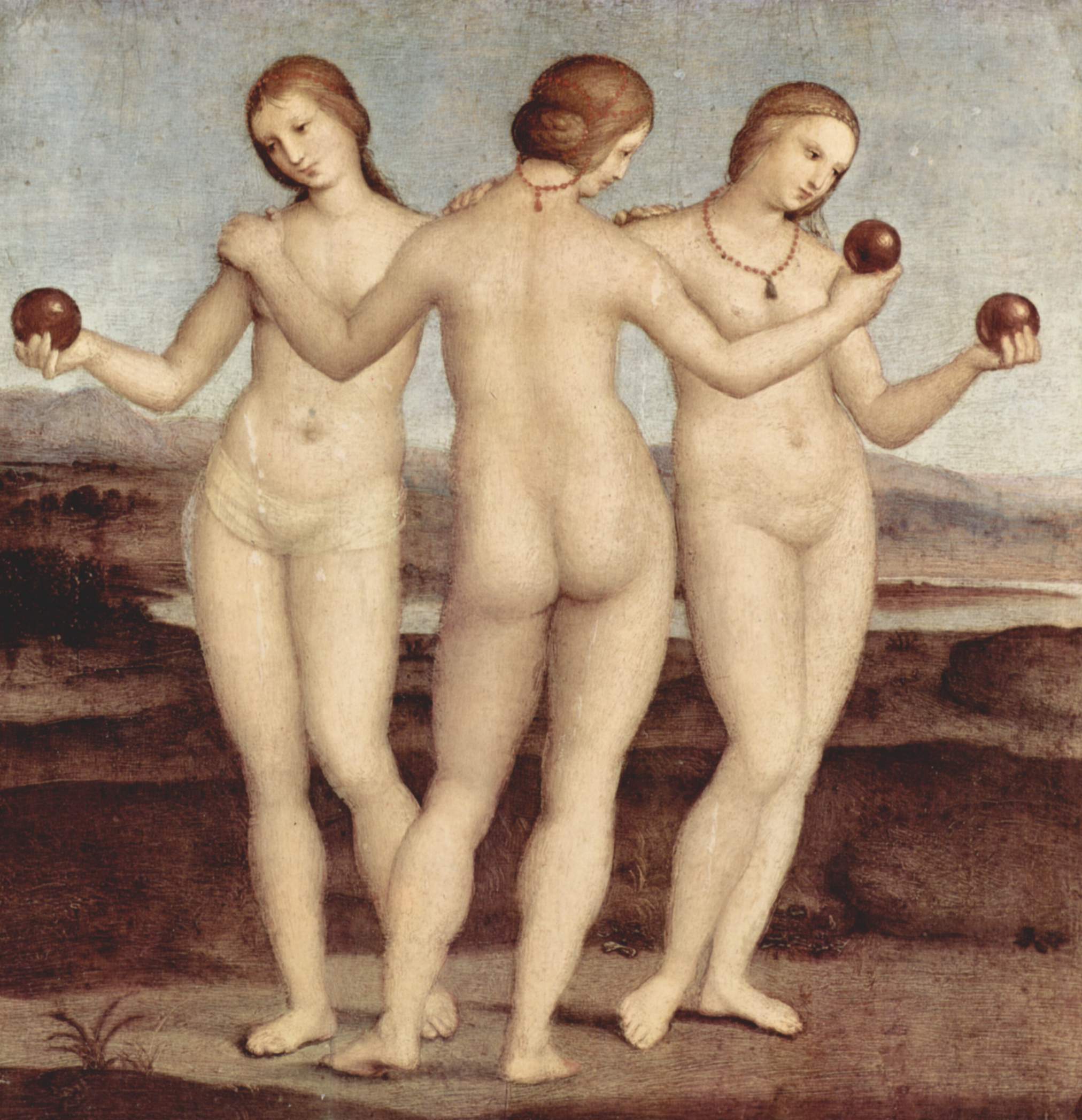
Raphael "The Three Graces" (1503-1505)
"The Three Graces," painted by Raphael around 1503-1505, is a captivating depiction of the classical mythological figures who symbolize grace, beauty, and festivity. This exquisite work showcases Raphael's early mastery of the High Renaissance style, with harmonious composition and delicate detailing. The painting portrays the three goddesses in a close, circular formation, embodying unity and mutual affection, set against a stark, natural backdrop that focuses attention on their intertwined figures. Raphael's use of soft, ethereal lighting highlights the gracefulness and idealized beauty of the subjects, making "The Three Graces" a timeless tribute to classical harmony and aesthetic perfection, and a testament to Raphael's genius in capturing the essence of human grace.
2. Self-portrait (1506)
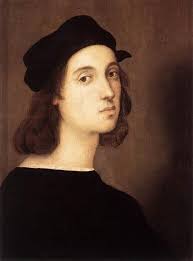
Raphael "Self-portrait" (1506)
Raphael's "Self-portrait" offers a rare glimpse into the artist's personal reflection during his early years. The portrait is characterized by its detailed realism and the subtle use of light and shadow, highlighting Raphael's mastery of the techniques that would later define the High Renaissance. Dressed in simple yet elegant attire, Raphael presents himself with dignity and a quiet assurance, foreshadowing the influential figure he was to become in the art world. This self-portrait not only provides insight into Raphael's self-perception but also serves as a testament to his skill in capturing the essence of human character and emotion. This work, housed in the Uffizi Gallery in Florence, showcases a young Raphael with an introspective gaze, embodying the confidence and potential of an artist on the brink of greatness.
3. Madonna of the Goldfinch (1506)

Raphael "Madonna Of The Goldfinch" (1506)
This beautiful image of the Virgin Mary holding the infant Christ and John the Baptist is created by Raphael somewhere between 1505 and 1506. The painting gets its name from the goldfinch held by John, symbolizing Christ's future Passion. Raphael's skillful use of color and light enhances the naturalistic setting and the intimate, sacred moment between the figures, while the circular arrangement emphasizes unity and balance. "Madonna of the Goldfinch" exemplifies Raphael's ability to convey deep spiritual themes with grace and serenity. This work, now housed in the Uffizi Gallery in Florence, is celebrated for its harmonious composition and the tender interactions among the figures.
4. The School of Athens (1509-1511)
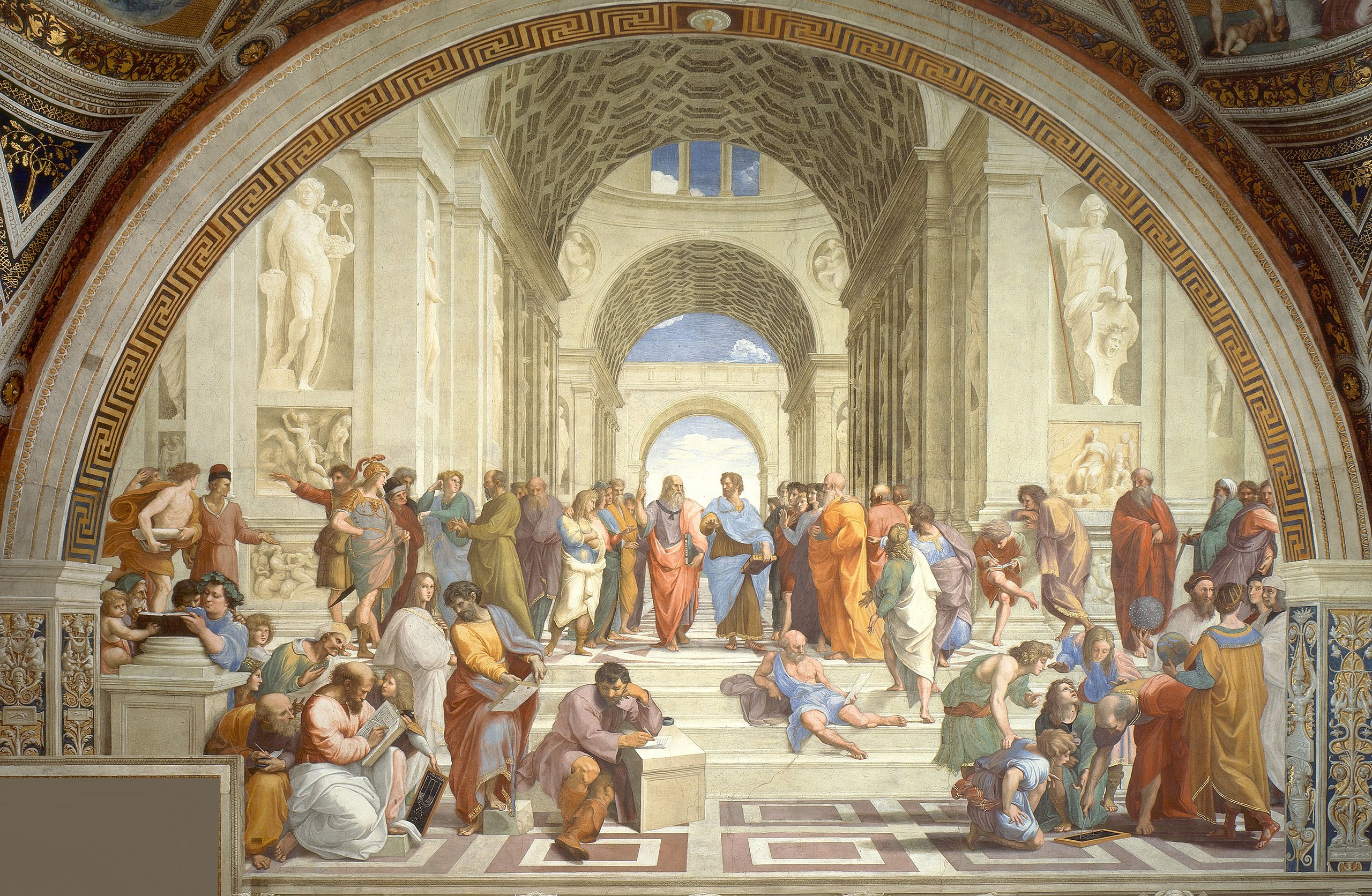
Raphael "The School Of Athens" (1509-1511)
"The School of Athens," a masterpiece by Raphael, is a quintessential representation of Renaissance humanism, painted between 1509 and 1511. Central figures Plato and Aristotle are shown in the heart of the composition, surrounded by other luminaries engaging in various intellectual discussions and activities. Raphael's skill in perspective, anatomy, and spatial coherence is on full display, creating a cohesive and dynamic scene that celebrates the pursuit of knowledge. The inclusion of Raphael's self-portrait among these ancient figures underscores the continuity between the Renaissance and Classical antiquity. "The School of Athens" stands as a monumental tribute to the power of human thought and creativity. This fresco, located in the Vatican's Apostolic Palace, vividly encapsulates the spirit of the Renaissance through its depiction of the most influential thinkers and scientists of ancient Greece gathered in a grand architectural setting.
5. The Disputation of the Holy Sacrament (1509-1510)

Raphael "The Disputation Of The Holy Sacrament" (1509-1510)
"The Disputation of the Holy Sacrament," painted between 1509 and 1510, is one of the masterpieces that adorns the Stanza della Segnatura in the Vatican. This fresco represents a theological debate regarding the Eucharist and serves as a visual synthesis of the heavenly and earthly realms of Christian belief. At the top, Raphael depicts a celestial gathering of Jesus, Mary, and saints, with God the Father above them, while below, theologians and Church Fathers, including St. Augustine and St. Thomas Aquinas, engage in discussion around an altar. The artwork is celebrated for its intricate composition, the harmonious interplay of figures, and the luminous portrayal of divine light.
6. The Sistine Madonna (1512)
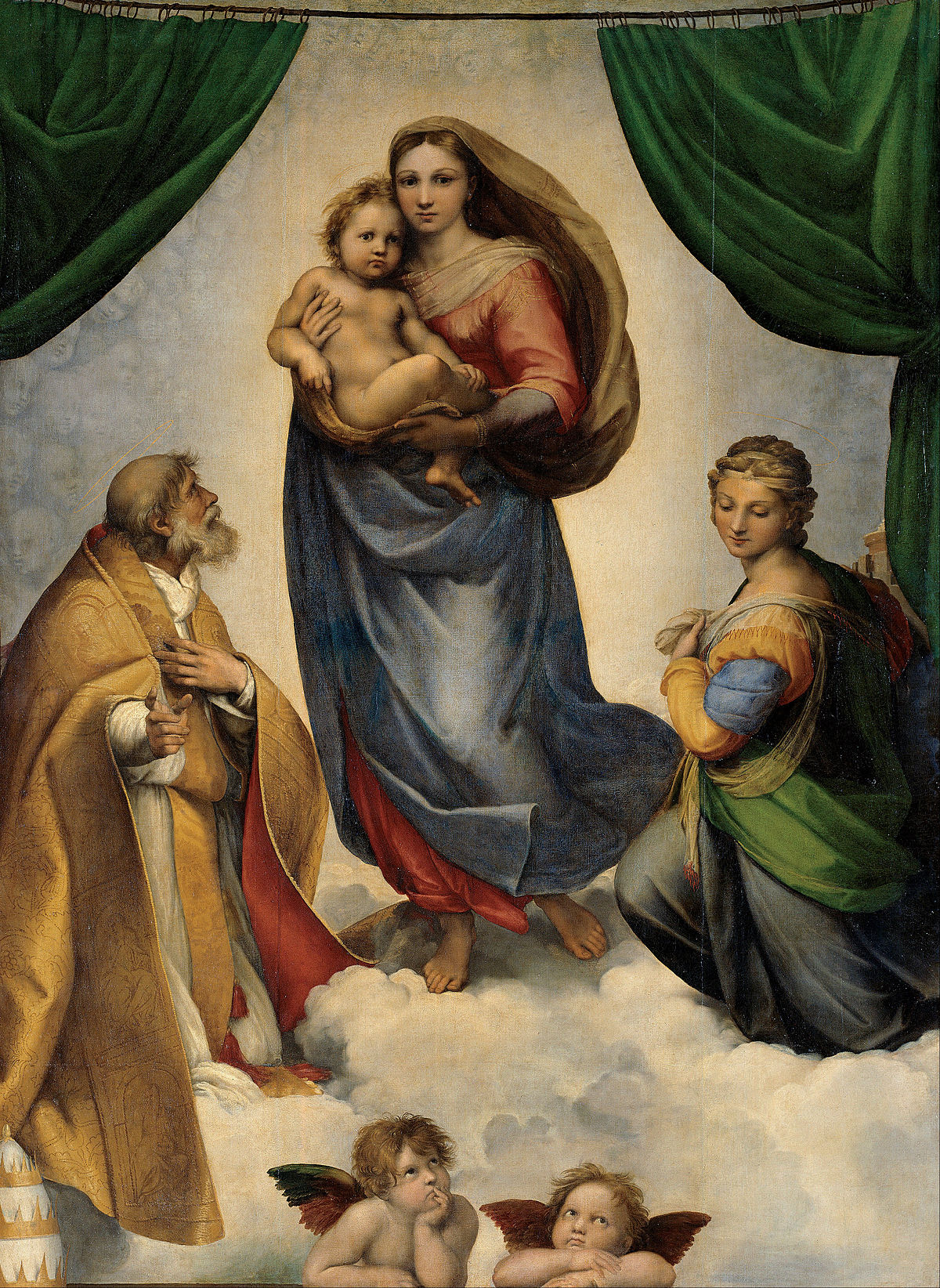
Raphael "The Sistine Madonna" (1512)
An iconic Renaissance masterpiece that beautifully captures the Madonna and Child, flanked by saints Sixtus and Barbara, against a backdrop of a mystic, cloud-filled heaven. The painting is also famous for the two cherubs at its base, which have become iconic in their own right. Raphael's use of vibrant colors and the dramatic play of light and shadow imbue the scene with a heavenly atmosphere, highlighting the painting's ethereal beauty and emotional depth. Currently housed in the Gemäldegalerie Alte Meister in Dresden, Germany, this work is renowned for its spiritual profundity and the innovative portrayal of the Madonna emerging from the clouds, directly engaging the viewer with an aura of serene grace.
7. The Triumph of Galatea (1514)
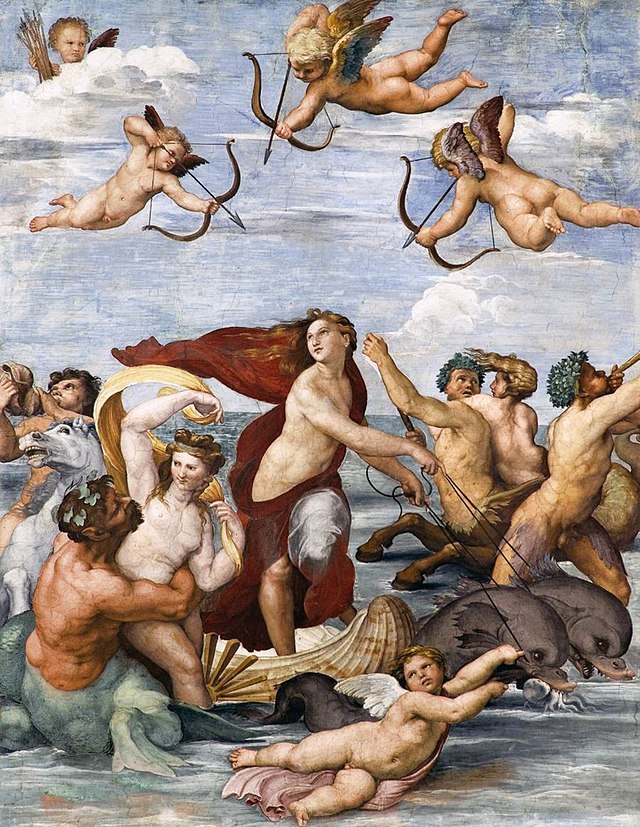
Raphael "The Triumph Of Galatea" (1514)
The painting is a vibrant depiction of the mythological nymph Galatea, immortalizing her escape from the cyclops Polyphemus and her journey across the sea, guided by dolphins. Raphael's mastery in rendering the figures, particularly Galatea, who is depicted with a serene yet joyous expression amidst a flurry of activity, showcases his ability to convey complex narratives through art. The use of vivid colors and the detailed depiction of the sea creatures and surrounding characters enhance the sense of motion and the ethereal quality of the scene. "The Triumph of Galatea" stands as a testament to Raphael's genius in capturing the beauty of the classical world and his unparalleled skill in the use of color and form to evoke emotion and narrative depth. This fresco, located in the Villa Farnesina in Rome, is celebrated for its dynamic composition and the exquisite portrayal of movement and grace.
8. Madonna della Seggiola (Madonna of the Chair) (1514)
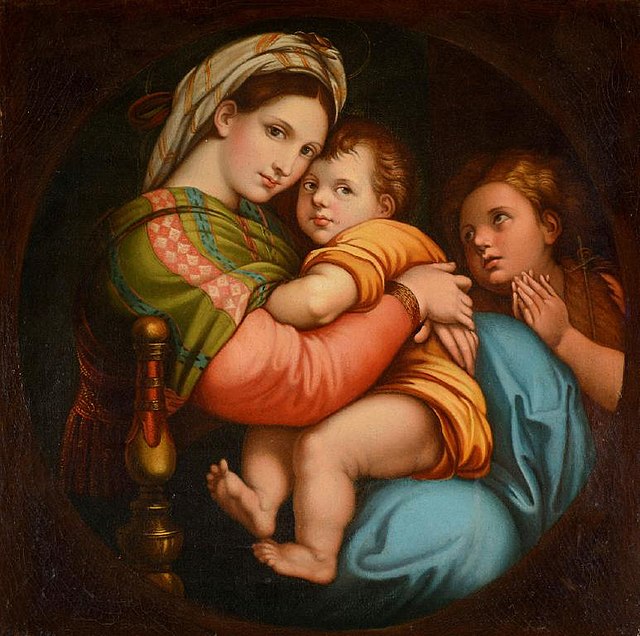
Raphael "Madonna Della Seggiola" (Madonna Of The Chair) (1514)
This is an intimate and warm portrayal of the Virgin Mary embracing the Christ Child, with the young John the Baptist attentively looking on. This circular painting, known as a tondo, is famed for its composition that captures a moment of familial tenderness in a very personal, accessible manner. The figures are closely entwined in a circular format that enhances the sense of closeness and unity among them. Raphael's use of rich, warm colors and the detailed rendering of the textures of their garments contribute to the overall feeling of intimacy. This work is celebrated for its departure from more formal religious compositions, presenting the holy figures in a relatable, domestic setting.
9. The Transfiguration (1516-1520)
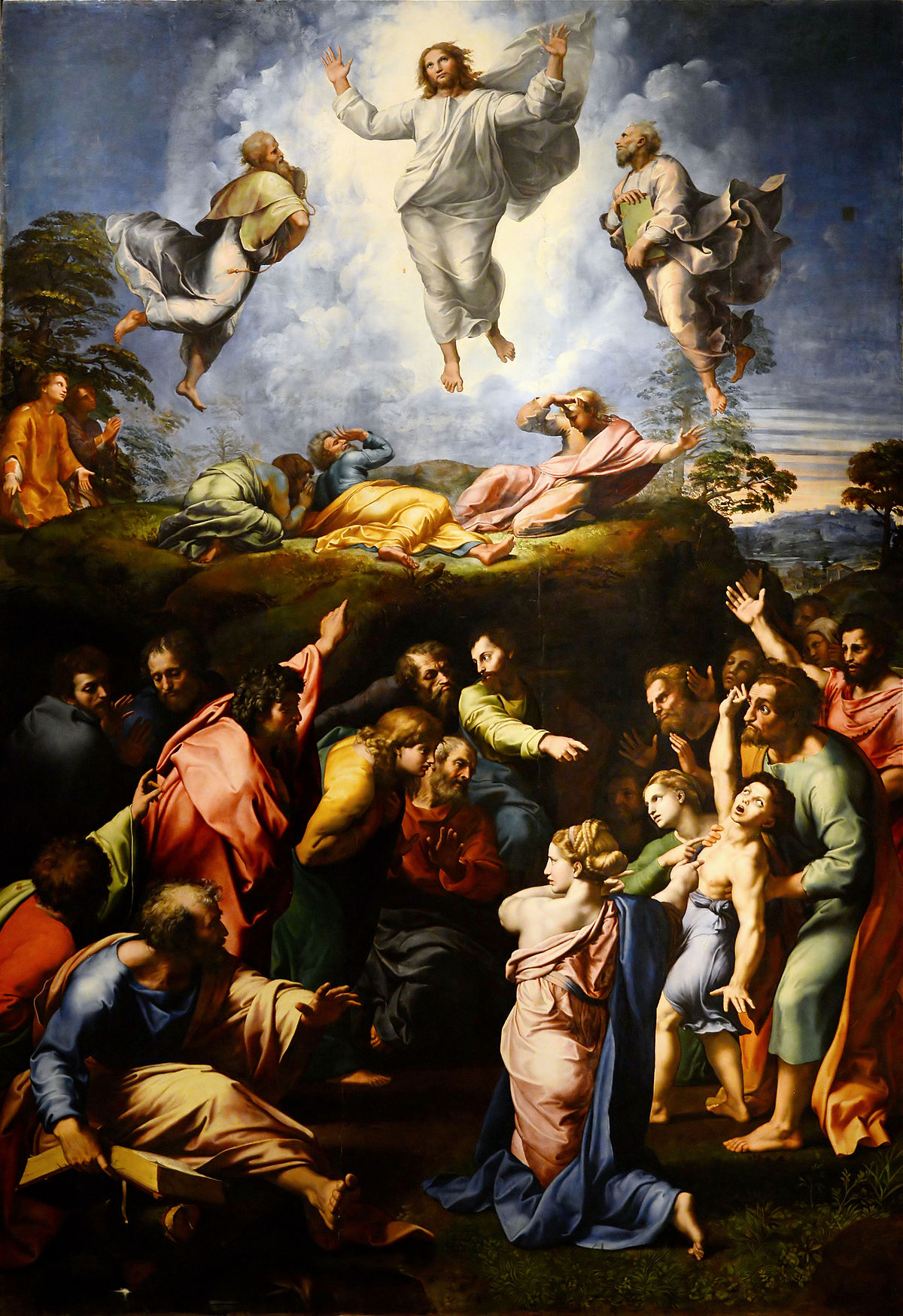
Raphael "The Transfiguration" (1516-1520)
The artwork, completed by Raphael in 1520, is considered one of his greatest masterpieces and the last painting he worked on before his untimely death. Raphael masterfully juxtaposes the divine radiance of Christ with the earthly turmoil below, employing a dynamic composition and a dramatic use of light to highlight the contrast between the celestial and the human realms. The vivid expressions and gestures of the figures further enhance the emotional intensity of the scene. "The Transfiguration" showcases Raphael's unparalleled ability to convey complex theological themes through his art, combining spiritual depth with technical brilliance, and remains a powerful testament to his legacy as one of the Renaissance's most gifted artists. This monumental work, now housed in the Vatican Museums, depicts the biblical story of Christ's transfiguration atop Mount Tabor, alongside the simultaneous narrative of the apostles attempting to heal a possessed boy at the mountain's base.
10. La Fornarina (1518-1520)
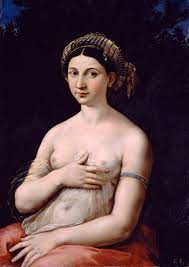
Raphael "La Fornarina" (1518-1520)
This is an intimate and sensuous portrait of Margherita Luti, believed to be Raphael's muse and lover. Margherita is depicted with a gaze that is both alluring and tender, her bare skin and the delicate placement of her hand over her heart suggesting a deeply personal connection between the artist and his subject. The detailed rendering of her attire and the intricate jewelry she wears, including a bracelet bearing Raphael's name, adds layers of intimacy and affection to the portrait. "La Fornarina" stands as a profound testament to Raphael's mastery of portraiture and his ability to convey complex emotions and relationships through his art. This masterpiece, housed in the Galleria Nazionale d'Arte Antica in Rome, showcases the artist's exceptional skill in capturing the beauty and vulnerability of the human form.
The Eternal Mastery of Raphael
Throughout his career, Raphael was not just a painter but also an accomplished architect, contributing significantly to the Renaissance's architectural heritage. He was appointed the architect of St. Peter's Basilica in 1514, a testament to his versatility and mastery in different art forms. From the divine beauty of "The Sistine Madonna" to the intellectual depth of "The School of Athens," each painting offers a glimpse into the mind of an artist who continues to influence the art world to this day.
Raphael's artistic legacy is a testament to his mastery over form, composition, and the delicate interplay of light and color, which have left an indelible mark on the history of art. His ability to imbue his subjects with a profound sense of grace, emotion, and humanity set new standards for the Renaissance and beyond.
To truly appreciate the genius of Raphael, a journey to Rome, Florence, and the Vatican is essential! There, amidst the splendor of these historic cities, one can encounter the remarkable masterpieces that celebrate Raphael's enduring legacy. His art, a blend of the divine and the earthly, invites us to explore the depths of human and spiritual experience, making a visit to these cities not just a trip but a pilgrimage in honor of one of the greatest artists the world has ever known...
No Comments Yet...